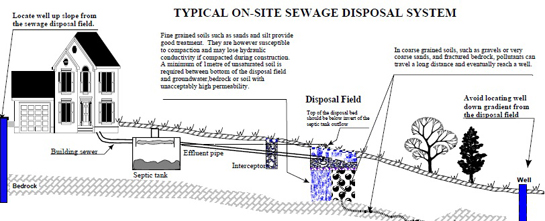- Standard and Appendices
- On-site Sewage Disposal Systems Standard
 (PDF:624k)
(PDF:624k) - Appendix A Tables for selecting an on-site sewage system
 (PDF:779k)
(PDF:779k) - Appendix B Determination of distribution trench width
 (PDF:182k)
(PDF:182k) - Appendix C Falling head permeameter test
 (PDF:572k)
(PDF:572k) - Appendix D Detailed cross section diagrams
 (PDF:2.9mb)
(PDF:2.9mb)
- On-site Sewage Disposal Systems Standard
- On-site sewage roles and certification requirements
- Installer
 (PDF:124k)
(PDF:124k) - Professional Engineer
 (PDF:67k)
(PDF:67k) - Septic Tank Cleaner
 (PDF:95k)
(PDF:95k) - Qualified Person
 (PDF:101k)
(PDF:101k)
- Installer
If you live in a rural community or if you have a cottage, you probably have an on-site sewage disposal system, also called a septic system. An onsite sewage system consists of a septic tank for settling and treatment as well as a sub-surface disposal field. About 45 per cent of homes in Nova Scotia have an on-site sewage disposal system. On-site systems must be properly designed, installed, used, and maintained to protect human health and the environment.

An on-site sewage disposal system uses natural processes to treat and dispose of the sewage or wastewater from buildings, such as private homes, where central wastewater collection is not available. A typical onsite system includes a septic tank and a disposal field that work together to treat the wastewater. Disposal fields are also called soil absorption areas or leach fields. Figure 1 shows an example of an on-site system. When properly designed, installed, used, and maintained, on-site systems are economical, effective, reliable, and safe, and can last for many years. However, a system that is poorly designed, installed, used, or maintained could:
- contaminate a water supply
- contaminate a watercourse, wetland, or marine water body
- harm human health
- cost a great deal to repair
To ensure proper maintenance of an on-site sewage disposal system, it is recommended that the septic tank be pumped empty of solids every two to three years, depending upon use, so that accumulated solids do not carry over into the disposal bed and plug the field, potentially causing the system to malfunction.
Check out this video on an innovative approach to municipal management of on-site systems recently introduced in Richmond County, Nova Scotia.

